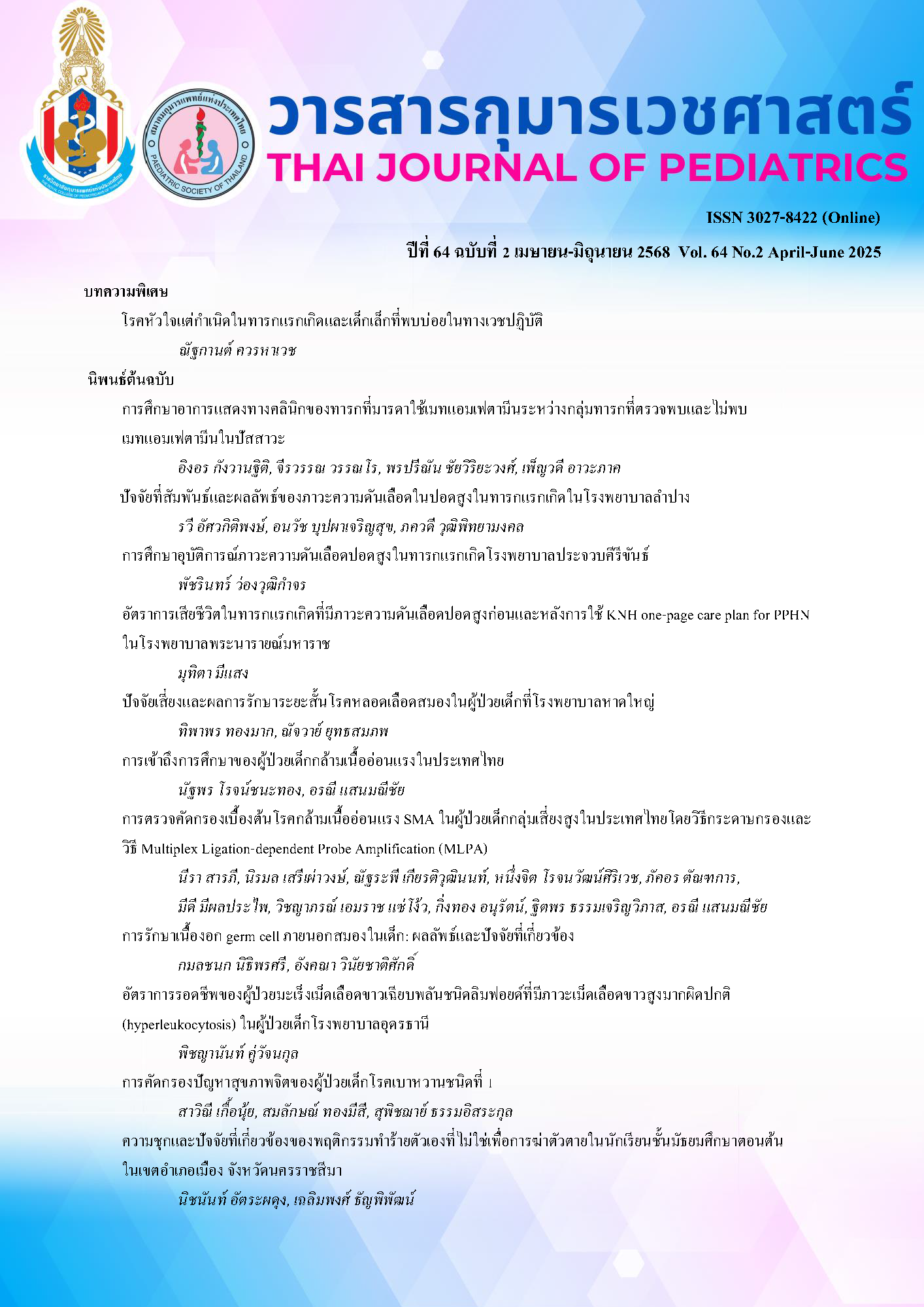Access to education of neuromuscular disease patients in Thailand.
Keywords:
Neuromuscular disease, Disability, Education system, SchoolAbstract
Background: Neuromuscular diseases are a group of disorders characterized by abnormalities in muscle function, neuromuscular junction signaling, or peripheral nerve function. Neuromuscular diseases cause progressive muscle weakness leading to mobility loss, while brain function and cognition remain intact. Literature from other countries indicates that patients often continue education and live normal lives, but in Thailand, mobility issues frequently lead to dropping out of school.
Objectives: This study aimed to known the accession of education of neuromuscular disease patients in Thailand, to identify factors contributing to the inability of these patients in education access, to explore patients' perspectives, and to assess their needs for additional support in education and classroom activities.
Methods: The cross-sectional study was conducted among patients aged 3 to 25 years old diagnosed with neuromuscular disease, at the Siriraj Neuromuscular Disease Center, Thailand between 1 August 2023 and 31 July 2024. A questionnaire was developed to collect factors associated with education.
Results: Among 105 patients with neuromuscular diseases, 73 were receiving education, 5 had never attended school, and 27 had dropped out. Most were diagnosed with DMD/BMD (36.3%), followed by SMA (26.7%). After adjusting for confounding, unsuitable school environments increased the risk of not attending school by 26.6 times. Patients who were wheelchair-bound or bedridden were 23.5 times more likely to not attend school, while those who had undergone surgery were 13.8 times more likely. Caregiver difficulties were associated with 22.3 times increased risk of school dropping out, and low household income (≤ 30,000 THB/month) was linked to a 10.9 times increased risk.
Conclusion: Among 105 patients with neuromuscular diseases, one-third were not attending school due to various barriers. Key risk factors included mobility limitations, low household income, scoliosis surgery, caregiver difficulties, and unsuitable school environments. Addressing these challenges is critical to improving educational access for these patients.
Downloads
References
Centers for Disease Control and Prevention (CDC). Prevalence of Duchenne/Becker muscular dystrophy among males aged 5-24 years - four states, 2007. MMWR Morb Mortal Wkly Rep. 2009;58:1119-22.
Strehle EM, Straub V. Recent advances in the management of Duchenne muscular dystrophy. Arch Dis Child. 2015;100:1173-7.
Donaldson A, Guntrum D, Ciafaloni E, Statland J. Achieving life milestones in Duchenne/Becker muscular dystrophy: A retrospective analysis. Neurol Clin Pract. 2021;11:311-7.
Mercuri E, Finkel RS, Muntoni F, Wirth B, Montes J, Main M, et al. Diagnosis and management of spinal muscular atrophy: Part 1: Recommendations for diagnosis, rehabilitation, orthopedic and nutritional care. Neuromuscul Disord. 2018;28:103-15.
Aksaralikitsunti M, Sanmaneechai O. Health-related quality of life in Thai children with spinal muscular atrophy. Pediatr Neonatol. 2022;63:291-7.
Bos I, Wynia K, Almansa J, Drost G, Kremer B, Kuks J. The prevalence and severity of disease-related disabilities and their impact on quality of life in neuromuscular diseases. Disabil Rehabil. 2019;41:1676-81.
A Teacher's guide to neuromuscular disease: Muscular dystrophy association; 2017. Available from: https://www.mda.org/sites/default/files/Teachers_Guide_booklet.pdf.
Thongsing A, Suksangkarn Y, Sanmaneechai O. Reliability and validity of the Thai pediatric quality of life inventory™ 3.0 neuromuscular module. Health and Quality of Life Outcomes. 2020;18:243.
Stroobach A, Wilson AC, Lam J, Hall GL, Withers A, Downs J. Factors influencing participation in home, school, and community settings by children and adolescents with neuromuscular disorders: A qualitative descriptive study. Dev Med Child Neurol. 2023;65:664-73.
Cruz KLT, Santos ICS, de Jesus Alves de Baptista CR, Mattiello-Sverzut AC. Quality of life assessment instruments in children and adolescents with neuromuscular diseases: A systematic scoping review. Health Qual Life Outcomes. 2024;22:18.
Wei Y, Speechley K, Campbell C. Health-related quality of life in children with Duchenne muscular dystrophy: A review. J Neuromuscul Dis. 2015;2:313-24.
Schepelmann K, Winter Y, Spottke AE, Claus D, Grothe C, Schröder R, et al. Socioeconomic burden of amyotrophic lateral sclerosis, myasthenia gravis and facioscapulohumeral muscular dystrophy. J Neurol. 2010;257:15-23.
Mah JK, Thannhauser JE, Kolski H, Dewey D. Parental stress and quality of life in children with neuromuscular disease. Pediatr Neurol. 2008;39:102-7.
Travlos V, Patman S, Wilson A, Simcock G, Downs J. Quality of life and psychosocial well-being in youth with neuromuscular disorders who are wheelchair users: A systematic review. Arch Phys Med Rehabil. 2017;98:1004-17.
Downloads
Published
How to Cite
Issue
Section
License
Copyright (c) 2025 The Royal College of Pediatricians Of Thailand

This work is licensed under a Creative Commons Attribution-NonCommercial-NoDerivatives 4.0 International License.



